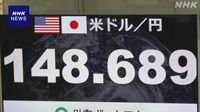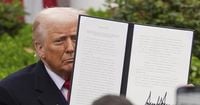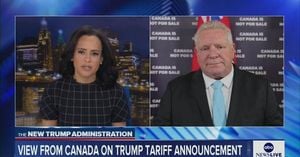The foreign exchange market in Tokyo on the morning of April 3, 2025, saw a significant shift as the yen strengthened against the dollar, reaching approximately 147.53 yen. This surge follows the recent announcement by U.S. President Donald Trump regarding reciprocal tariffs, which was less favorable than many market participants had anticipated, raising concerns about a potential global economic downturn.
In the wake of Trump's announcement, the dollar index hit its lowest point of the year, reflecting a broader trend of dollar selling against major currencies. The euro-yen exchange rate climbed to around 160.12 yen, while the pound-yen rate reached approximately 192.31 yen, and the Australian dollar-yen rate settled at about 92.31 yen. This movement indicates a strong performance of the yen against these currencies.
Market analysts noted that the tariffs, which Trump specified would be a uniform 10% on all countries, were lower than the expected rates. Initial reports suggested rates around 20%, leading to a brief period of dollar selling. However, as details emerged showing that tariffs on major economies like China (34%), Japan (24%), and the Eurozone (20%) were considerably higher, the market reacted with increased yen buying as investors sought to mitigate risk.
According to MINKABU PRESS, the yen's rise was not solely due to risk aversion but also reflected a notable trend of dollar selling against European currencies. The Australian and New Zealand dollars, however, showed some resilience against the dollar, providing a supportive backdrop for cross-currency trading.
On April 2, the dollar-yen exchange rate had already seen a decline of about 0.2% based on closing values. This decline was attributed to the market's reaction to the tariff announcement, which was perceived as more stringent than expected. The former Bank of Japan board member, Adachi, indicated that if the U.S. tariff policy does not significantly disrupt the Japanese economy, further interest rate hikes could be on the table at the upcoming Bank of Japan Monetary Policy Meeting in May.
Additionally, the ADP National Employment Report for March revealed an increase of 155,000 jobs, surpassing market expectations of 120,000, indicating a robust job market that could influence future economic policies.
As the foreign exchange market reacted to these developments, concerns about the implications of the tariffs on the U.S. economy began to surface. Analysts suggest that the tariffs could contribute to a slowdown in economic growth, prompting a decline in long-term interest rates in the U.S. This has led to a further shift in market dynamics, pushing traders to sell dollars in favor of the yen.
Looking ahead, the immediate downside target for the dollar-yen pair is around 147.67 yen, which aligns with the lower limit of the weekly Ichimoku cloud. Should the rate fall below this threshold, it could potentially target the low of 146.55 yen recorded on March 11, 2025.
The market is also closely monitoring upcoming economic indicators, including the U.S. Initial Jobless Claims and the ISM Non-Manufacturing Index for March, as these will provide further insights into the health of the U.S. economy and its potential response to the recent tariff measures.
In the European Union, officials are preparing emergency support measures aimed at sectors likely to be adversely affected by the tariffs. This proactive approach highlights the broader implications of Trump’s tariff strategy, which could strain international relations and economic stability.
As the foreign exchange market continues to adjust to these developments, traders are advised to remain vigilant regarding the evolving economic landscape. The interplay between U.S. economic policy, global market reactions, and currency fluctuations will be crucial in the coming weeks.
In summary, the recent announcements surrounding U.S. tariffs have significantly impacted the foreign exchange market, leading to a stronger yen and a decline in the dollar's value. The situation remains fluid, with ongoing developments expected to shape trading strategies and economic forecasts.







